- Joined
- Jun 23, 2024
- Messages
- 45
Suppose the unthinkable happens, leaving you stuck out in the woods in an emergency or even a zombie apocalypse. In that case, you need to have a reliable survival knife at your side. It needs to be a versatile tool that can handle everything from digging, prying, chopping, and cutting to building a shelter, processing firewood, food prep, and even self-defense. The Rat-7 by Ontario Knife Company (OKC) fulfills all those duties and can be the difference between life and death in such an emergency.
Made in the USA and built from high-performing 1095 steel (some of the more recent units used 1075, also a very durable steel), this tool is a perfect balance between durability and handleability. Its blade length of 7.2" with a cutting length of 6.7" on a spine thickness of 0.19" (4.8mm makes it one of the best options for both survival and bushcrafting, although its forte is the former.
The full flat-ground 1.5" wide makes it nicely slicey, albeit at the slight cost of wood processing capability (splitting wood, for example). However, the flat grind adds to its ability for chopping, especially combined with its 20 oz. weight, longer length, and the ability to add paracord to allow for a 3-finger grip for chopping.
The linen micarty handle is exceptionally grippy, although some would call it slightly blocky. That said, despite the lack of the arguably sexier lines of its offspring, ESEE, the handle is very comfortable even for long and arduous tasks. Many owners of this knife reprofile the handle slightly to make the contours rounder. I like the stockier handle geometry and will likely leave mine as is.
The blade offers a usable finger choil at the ricasso, allowing you to choke up on the blade for more nuanced tasks such as wood carving. That said, this is more of a bold-strokes tool and less adept at fine work than a traditional bushcraft knife (such as a Mora Garberg). Although 1095 has almost no corrosion resistance (it rusts at practically any sign of water), the zinc phosphate powder coat does offer some protection. If you dry it thoroughly after water contact and keep the blade well-oiled, you'll have little to no issue with rust.
One of the knife's greatest attributes is its ease of sharpening. Although 1095 does not provide extensive corrosion resistance or edge retention, it's incredibly tough and extremely easy to sharpen. I've sharpened 1095 with everything from a pocket sharpener, a portable diamond, and a traditional whetstone to ceramic mug bottoms, an old spark plug, and even a granite boulder. That versatility alone makes it invaluable in the field and extreme situations. Speaking of sharpness, mine arrived none-too-sharp, but as I stated, it is quite easy to sharpen, so after a few passes on the diamond plate, it was ideal.
The biggest problem with the knife (in my humble opinion) is its included sheath. It's made of Cordura nylon with a plastic insert to maintain its shape and prevent the edge from slicing it open. It's far less sturdy than a Kydex/GRN or a quality leather sheath. (Leather sheaths are strong but retain moisture, so they are not the best for 1095 knives).
Kydex and Glass-reinforced nylon (GRN) are hard-sided materials that do not retain moisture. However, they are more costly and, therefore, not included. Myriad aftermarket sheaths are available, but their main downside is the additional cost. Given that the knife is already running around $100 (USD), adding another $50-$100 for a sheath puts the cost in the realm of other, more refined knives. So, in that vein, the included nylon sheath will likely suffice for you unless you simply want something nicer. It serves as a carrying implement, provides moderate protection, and is relatively secure, although a little noisy (see included video below).
Overall, the Ontario Rat-7 is an incredibly versatile survival knife that can do a lot. Although more suited to large-scale tasks, it's surprisingly nimble. Its long service record and reputation make it one of the most revered knives in its class. It's just too bad that OKC has closed its doors. That said, you can still find remaining new stock at some outlets. Otherwise, you'll need to search the resale market for one.
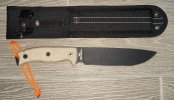
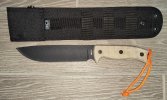
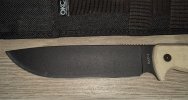
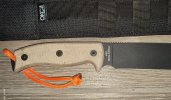
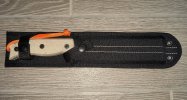
Made in the USA and built from high-performing 1095 steel (some of the more recent units used 1075, also a very durable steel), this tool is a perfect balance between durability and handleability. Its blade length of 7.2" with a cutting length of 6.7" on a spine thickness of 0.19" (4.8mm makes it one of the best options for both survival and bushcrafting, although its forte is the former.
The full flat-ground 1.5" wide makes it nicely slicey, albeit at the slight cost of wood processing capability (splitting wood, for example). However, the flat grind adds to its ability for chopping, especially combined with its 20 oz. weight, longer length, and the ability to add paracord to allow for a 3-finger grip for chopping.
The linen micarty handle is exceptionally grippy, although some would call it slightly blocky. That said, despite the lack of the arguably sexier lines of its offspring, ESEE, the handle is very comfortable even for long and arduous tasks. Many owners of this knife reprofile the handle slightly to make the contours rounder. I like the stockier handle geometry and will likely leave mine as is.
The blade offers a usable finger choil at the ricasso, allowing you to choke up on the blade for more nuanced tasks such as wood carving. That said, this is more of a bold-strokes tool and less adept at fine work than a traditional bushcraft knife (such as a Mora Garberg). Although 1095 has almost no corrosion resistance (it rusts at practically any sign of water), the zinc phosphate powder coat does offer some protection. If you dry it thoroughly after water contact and keep the blade well-oiled, you'll have little to no issue with rust.
One of the knife's greatest attributes is its ease of sharpening. Although 1095 does not provide extensive corrosion resistance or edge retention, it's incredibly tough and extremely easy to sharpen. I've sharpened 1095 with everything from a pocket sharpener, a portable diamond, and a traditional whetstone to ceramic mug bottoms, an old spark plug, and even a granite boulder. That versatility alone makes it invaluable in the field and extreme situations. Speaking of sharpness, mine arrived none-too-sharp, but as I stated, it is quite easy to sharpen, so after a few passes on the diamond plate, it was ideal.
The biggest problem with the knife (in my humble opinion) is its included sheath. It's made of Cordura nylon with a plastic insert to maintain its shape and prevent the edge from slicing it open. It's far less sturdy than a Kydex/GRN or a quality leather sheath. (Leather sheaths are strong but retain moisture, so they are not the best for 1095 knives).
Kydex and Glass-reinforced nylon (GRN) are hard-sided materials that do not retain moisture. However, they are more costly and, therefore, not included. Myriad aftermarket sheaths are available, but their main downside is the additional cost. Given that the knife is already running around $100 (USD), adding another $50-$100 for a sheath puts the cost in the realm of other, more refined knives. So, in that vein, the included nylon sheath will likely suffice for you unless you simply want something nicer. It serves as a carrying implement, provides moderate protection, and is relatively secure, although a little noisy (see included video below).
Overall, the Ontario Rat-7 is an incredibly versatile survival knife that can do a lot. Although more suited to large-scale tasks, it's surprisingly nimble. Its long service record and reputation make it one of the most revered knives in its class. It's just too bad that OKC has closed its doors. That said, you can still find remaining new stock at some outlets. Otherwise, you'll need to search the resale market for one.





Last edited:
